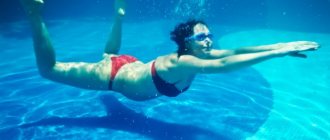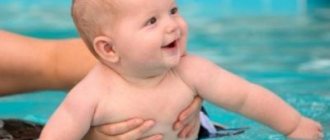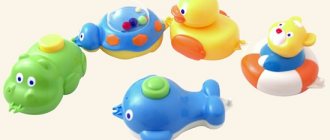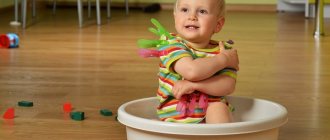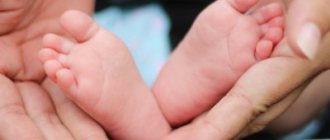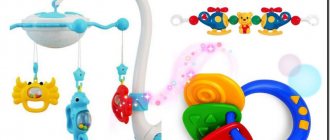The child spends the first nine months of his intrauterine life in the aquatic environment, adapting and adjusting to it. In this regard, many experts support the point of view that children should be taught to swim almost from the moment they are born. At the everyday level, there are different opinions on this matter. Thus, some are convinced that swimming for infants promotes complex and all-round development; others do not share this optimism, considering popular activities to be just a newfangled trend. Let's try to figure out whether swimming is really beneficial for newborns.
Is it good for newborns to swim?
Note that already at the moment of birth, all children can swim and hold their breath. This is due to the characteristics of the environment in which they developed inside the womb. The ability of a newborn to swim is not a masterly control of his own body, as is the case with professional athletes, but an innate reflex. It is lost by 3–4 months of a baby’s life. That is why parents who decide to practice swimming for newborns should start almost immediately after birth. If the reflex fades, water activities are undesirable for the child until he reaches 4–5 years of age.
Infant swimming at home in a bathtub or in a pool with a qualified specialist is not a way to raise a future Olympic champion. Classes are aimed at achieving other goals , which are listed below.
- Staying in an aquatic environment allows the child’s body to become more resistant to temperature changes and hardens it. As a result, strong acquired immunity is formed and the risk of contracting a viral disease is reduced. Practice shows that children accustomed to swimming from infancy get sick much less often than their peers.
- The benefits of infant swimming are also obvious for the cardiovascular system. While in water, the pressure of compensatory forces decreases, and the blood begins to circulate faster. Gradually, this leads to strengthening of the heart muscle and the cardiovascular system as a whole.
- Even minor physical activity in water contributes to the development of the musculoskeletal system. According to statistics, swimming children begin to crawl faster and take their first steps earlier than their peers.
- While swimming, the baby can relax, his muscles relax, and spasms are relieved. A similar result cannot always be achieved even through a special infant massage.
- Early swimming exercises form a muscular corset and correct posture, which helps avoid the development of diseases associated with the back and spine (for example, scoliosis).
- When a child swims, he reflexively holds his breath. Firstly, it improves the functioning of the respiratory system. And, secondly, it activates the formation of erythrocytes (red blood cells) in the blood, and the level of hemoglobin increases.
- Breast swimming normalizes blood pressure.
- Swimming increases appetite, so the child gains weight better.
- At a natural instinctive level, children feel the need to dive while swimming. This makes them feel more secure and returns them to their comfort zone. In addition, water flowing into the maxillary sinuses during diving cleans them, ridding the mucous membranes of bacteria and dust particles.
- Water has a calming effect. Babies accustomed to swimming are calmer and less fearful. As they grow up, they do not acquire obsessive childhood fears.
It will also be useful for mothers to know that while swimming, children expend a lot of energy, so they quickly and without any problems fall asleep at night, without disturbing their parents.
Infant swimming: arguments for and against
First, about the pros. When visiting the pool regularly, the following occurs:
- strengthening the musculoskeletal system,
- muscle development, lung training,
- strengthening the immune system,
- affects appetite and daily routine.
However, there is a serious question that requires an answer: at what age do swimming pools begin to bring such benefits? Is it likely that starting classes too early will have serious negative consequences?
In 2010, pediatricians in Germany, France and Belgium began to talk in unison about the dangers of indoor swimming pools for infants. According to the results of serious studies conducted in Europe, among children who regularly played in the pool before the age of 2 years, cases of respiratory tract diseases were 4 times more likely compared to those who visited the pool rarely or not at all. It turned out that this was a consequence of exposure to chlorine compounds in the pool air.
Since then, many aquatic complexes have begun to use new cleaning methods and now claim that infant swimming has become safe.
But since there was a precedent, there is a possibility that we are still missing something that only new research will shed light on.
What parents need to know
It was already noted above that children have special reflexes that allow them to stay on the water. It will be useful for parents who decide to develop such natural abilities to know how to teach their newborn to swim. This is not difficult to do by following simple recommendations.
- Age. Swimming of newborns in the bath can be practiced when they reach 3–4 weeks. It is by this time that the umbilical wound heals, and the child begins to adapt to the environment.
- Bath. Your child's first swimming lessons should be given in the same bathtub in which you bathed him before. A change of environment will cause a feeling of fear in the child and will not give the desired result. You should also be responsible about keeping the bath clean. Before bathing, it should be washed with laundry soap and treated with soda 1-2 times a week (disinfectants are not suitable, as they can cause allergic reactions in the newborn).
Thus, the first lessons should take place in a familiar environment - in the bathtub; as the baby develops certain skills, he can be transferred to a large bathtub, and then to the pool.
- Water. Initially, it should be no lower than 35 and no higher than 37 degrees. The degree can be lowered as the newborn adapts, thereby hardening it. The lowest possible temperature is 32 degrees.
And also during training, you cannot stop monitoring the child’s behavior. For example:
- A baby's continuous crying while immersed in water may indicate that the water temperature is either too hot or too cold.
- If after a few seconds the baby calms down and stops crying, you have selected the water at the optimal temperature.
- Excessive passivity of the baby during bathing indicates that the water is too warm. She has a soothing effect on him.
Many young parents worry about the water cooling down while swimming. There is no need to worry, because this is one of the goals of infant swimming at home - to strengthen the child.
Free swimming
The “School of Social Entrepreneurship” became not only a launching pad for the implementation of my idea to develop a city museum, but also a source of inspiration for my own business. One of my “school” classmates came to the program with a project for an infant swimming center for children from 2 months to 3 years old. Until that moment, I had never thought about this area, but, becoming interested, I decided to conduct real research: I traveled to Kemerovo, Krasnoyarsk, Abakan, and got acquainted with similar centers from the client’s side. In the end, I decided to open my own center, especially since I had no competitors in Sharypovo.
My children's infant swimming center "Octopus" opened in December 2020. Preparations for the launch took almost a year and cost me 1.7 million rubles. The most important expense item was the purchase of premises. I understood that it was necessary to open an infant swimming center where there was developed infrastructure and good transport accessibility. Plus, numerous SanPiNs and GOSTs imposed serious restrictions on me. I was very lucky that at that moment a municipal premises of 50 square meters was for sale. m, ideally suited to all my requirements.
With the idea of launching a children's center at this point, I came to a meeting with the chairman of the city council of deputies, and the local administration met me halfway.
This purchase cost me 250,000 rubles. own savings. Another about 1.5 million rubles. spent on repairs, purchasing equipment, training staff and advertising “Octopussy”. I borrowed this money from the bank. At the same time, I tried to be as active as possible - I participated in all available support programs for start-ups and social entrepreneurs in the region.
In 2020, I became the winner of the annual interregional competition for graduates of the School of Social Entrepreneurship “Creation - 2016” and received a grant of 250,000 rubles, and also attracted a subsidy of 500,000 rubles. to start a business activity. I managed to attract another half a million in the form of an interest-free loan from the Our Future social initiatives fund. But even taking into account all these victories in less than two years, we have not yet managed to return the investment.
The basics of swimming in the bath
All water activities with the baby should be carried out a couple of hours after eating, when the formula or breast milk has had time to be digested, and the feeling of hunger has not yet set in. And also, you should only swim with a well-slept and rested child, otherwise hysterics and tears cannot be avoided.
Step-by-step instructions on how to teach a baby to swim in the bathtub:
- Gently holding the child, lower him into water at the optimal temperature. Wait for his first reaction. If the baby cries, do not rush to get him out right away, give him a little time to get comfortable.
- When the crying has subsided, move the child to a horizontal position, lightly holding the back. It is noteworthy that you yourself must stand firmly on your feet, leaning over the bathtub.
- When you understand that the baby is accustomed to water, you can begin performing swimming exercises, which will be discussed later.
Please note that the floor in the bathroom must be covered with special rubber mats to prevent slipping.
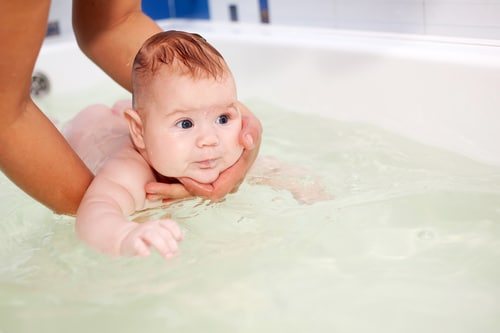
Bathroom exercises for baby swimming:
- We lay the child in a horizontal position on his back, securing his body with the palm of his hand from below. Gradually move your hand from the back to the back of the head. As a result, the child floats on the water on his own, and the mother only insures him by holding his head.
- We lower the child into the water in a diagonal position, tummy down. The mother must quickly find her bearings and pick up the baby’s head, placing his chin in her palm.
- We lower the child into the water in a horizontal position, with his back facing the bottom of the bath, his legs placed at one of the sides. Feeling support, he pushes off from the wall and tries to swim on his own. This exercise can be performed only when the baby is already comfortable in the water and learns to stay on its surface without support.
- We lower the newborn into the water with his stomach down. The body should be completely immersed in the liquid, only the head remains on the surface, which the mother holds by the chin. Having coordinated the child, demonstrate to him that you can splash in the water. By repeating the actions shown, he will eventually learn to row correctly.
- When the baby learns to easily do the exercises listed above, the load can be increased. It is assumed that by this moment he will not only keep his body on the surface of the water, but also independently move along its plane.
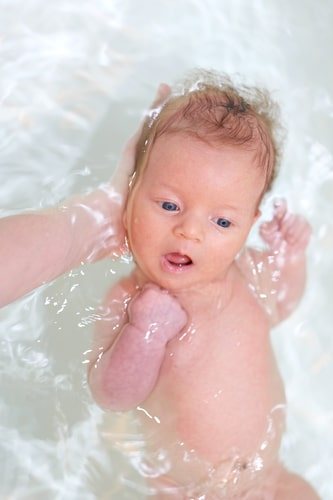
So, the baby splashes in the water, the mother insures him. Not far from it, about 10 centimeters, a bathing toy is placed. The child must swim to her. Over time, the distance between the baby and the toy should increase.
- When your baby can already swim independently over relatively long distances, both on his back and not on his stomach, start doing the figure eight exercise with him. It involves a visual repetition of the outlines of the number by the baby.
- Supporting the baby by the tummy from below, lift him out of the water and submerge him back. This exercise helps develop coordination and strengthen the cardiovascular system.
- Once your newborn gets used to the water, you can practice diving. At the reflex level, when completely immersed, he will hold his breath, so you should not be afraid of this exercise. You can teach your child to dive only after 5–10 minutes of free swimming.
Diving is done as follows: holding the baby firmly in your hands, we plunge him headlong into the water for a few seconds; repeat the procedure up to 5 times.
These water exercises are not at all difficult, but they give noticeable results. In addition, parents should remember that swimming for babies in the pool is possible only after preliminary home preparation in the bathroom.
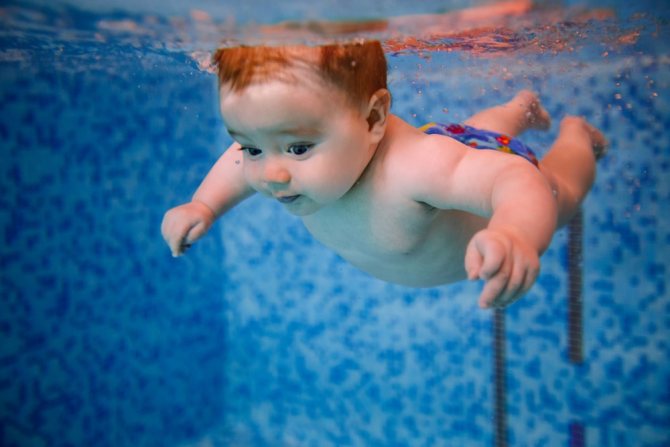
Sports (professional) swimming for children
Most sections working with younger groups accept children from 3 years of age. Swimming of younger children is classified as infant swimming. In this case, by the age of 1.5-3 years the child will already feel at home in the water, as if in his own element, and will learn to dive. Such a child will be ready to learn professional swimming at 3 years old.
Morning exercises for kids with music
At the age of 3, classes (in addition to the benefits from the sports activities themselves) teach you to think, listen and hear the coach. The baby splashes out energy, develops coordination and relaxes.
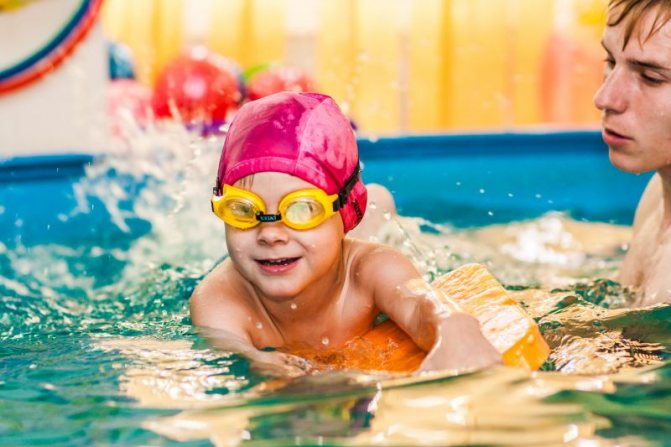
Child athlete
The beginning of training consists of familiarization with the basics of sports activities. The child learns not to be afraid of water, studies it more closely, and learns its properties. Next, the baby will study the effect of water on moving in space, learn to relax and lie on the water surface. Classes are held in the presence of adults.
Attention. When sending your baby to the section, you should make sure that the trainer has sufficient experience and qualifications. To work with young children you need to have great endurance, patience and teaching skills.
Closer to the beginning of school age, the child receives a more expanded understanding of science. At this age, he is ready to learn professional swimming. The guys practice in various styles and do the exercises necessary for this.
By the age of 7-8, promising girls and boys will be able to learn sports professionally. To do this, you can choose both standard directions and diving. Many people even like synchronized swimming.
A child who dreams of playing sports professionally must take a preliminary health course. After this stage, the baby will already have certain skills, the child will understand in practice what swimming is, and will clearly understand whether he likes it or not.
Classes include not only training in the pool, but at the same time the child develops in all respects, practicing different types of loads. For example, training in the gym or on exercise machines.
The child will be allowed to participate in classes after the health course trainer confirms the child’s learning abilities, as well as after passing a medical commission. The latter confirms that the child has no contraindications to playing this sport. You should also be prepared for the fact that training will be carried out every day.
Note. If it is decided that your child will go to the section, you need to purchase the necessary equipment and swimming clothes. In addition to standard slippers, a bathing suit and hygiene items, the child will need special equipment. These include goggles, safety sleeves, belts or boards. The issue of purchasing equipment is discussed with the coach individually.
Be sure to take into account that the activity should bring a pleasant impression. If your child does not want to engage in this sport, then you can consider other options. In this case, the pool can be visited for leisure.
A set of exercises for spinal scoliosis in children
Pool for newborns
Swimming a newborn in the pool is not just a process of teaching him basic water movements; This is a way of all-round development. Classes here, as a rule, begin at 2 months of age, provided that the child has previously mastered basic swimming exercises in a home bath.
Leading pediatricians advise visiting the pool no more than 3 times a week. The duration of the lesson for a two-month-old baby is ten minutes; as they grow older, it increases by half a minute every month.
Tips for visiting a public pool:
- Always wear a baby rubber cap on your newborn, which will protect the delicate scalp and hair from hard chlorinated water.
- The optimal visiting time for a child’s body is from 10 to 12 o’clock, try to fit within this time interval.
In the pool, you can practice with your child the same exercises that you mastered in the bathtub, gradually increasing their intensity. If you wish, you can enroll in an appropriate group or hire an instructor who specializes in teaching newborns. However, this is not necessary - the rules for teaching a baby to swim in the pool are identical to the rules for a bath.
The dangers of swimming in the pool during infancy
Due to the increased popularity of infant swimming, scientists have also shown interest in this phenomenon. Recent studies conducted in Europe have shown that playing at such a young age in public swimming pools causes harm to the respiratory system. This is due to the high concentration of water and the addition of chlorine to it. Chemical elements can cause allergic reactions in children and provoke the development of asthma and other chronic diseases.
In addition, bleach is also harmful to children’s delicate skin. It dries it out and makes it more susceptible to the environment. In special cases, contact with chlorinated water may cause bright red spots, similar to minor burns, to form on the body of infants.
Thus, swimming in public pools can indeed be dangerous for the baby due to the chlorine content in the water, but nowadays there are also swimming centers where disinfection is carried out using other means. So sensitive parents can always find an alternative.
